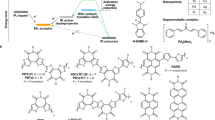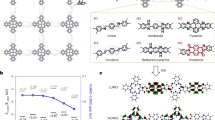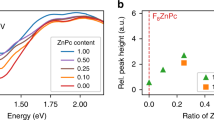Abstract
Chemical doping offers promise as a means of tailoring the electrical characteristics of organic molecular compounds. However, unlike for inorganic semiconductors used in electronics applications, controlling the influence of dopants in molecular complexes is complicated by the presence of multiple doping sites, electron acceptor levels, and intramolecular correlation effects. Here we use scanning tunnelling microscopy to analyse the position of individual Li dopants within Cu- and Ni-phthalocyanine molecules in contact with a metal substrate, and probe the charge transfer process with unprecedented spatial resolution. We show that individual phthalocyanine molecules can host at least three distinct stable doping sites and up to six dopant atoms, and that the ligand and metal orbitals can be selectively charged by modifying the configuration of the Li complexes. Li manipulation reveals that charge transfer is determined solely by dopants embedded in the molecules, whereas the magnitude of the conductance gap is sensitive to the molecule–dopant separation. As a result of the strong spin–charge correlation in confined molecular orbitals, alkali atoms provide an effective way for tuning the molecular spin without resorting to magnetic dopants.
This is a preview of subscription content, access via your institution
Access options
Subscribe to this journal
Receive 12 print issues and online access
$259.00 per year
only $21.58 per issue
Buy this article
- Purchase on Springer Link
- Instant access to full article PDF
Prices may be subject to local taxes which are calculated during checkout






Similar content being viewed by others
Change history
11 March 2013
In the version of this Article originally published online, at the start of the second paragraph of the section 'Doping limit of single MPc', the sentence describing a figure that "shows the dI/dV spectra as a function of the number of Li atoms" should have referred to Figure 5b rather than 4b. This error has been corrected in all versions of the Article.
References
Walzer, K., Maennig, B., Pfeiffer, M. & Leo, K. Highly efficient organic devices based on electrically doped transport layers. Chem. Rev. 107, 1233–1271 (2007).
Tosatti, E., Fabrizio, M., Tóbik, J. & Santoro, G. Strong correlations in electron doped phthalocyanine conductors near half filling. Phys. Rev. Lett. 93, 117002 (2004).
Hebard, A. F. et al. Superconductivity at 18 K in potassium-doped C60. Nature 350, 600–601 (1991).
Mitsuhashi, R. et al. Superconductivity in alkali-metal-doped picene. Nature 464, 76–79 (2010).
Takenobu, T., Muro, T., Iwasa, Y. & Mitani, T. Antiferromagnetism and phase diagram in ammoniated alkali fulleride salts. Phys. Rev. Lett. 85, 381–384 (2000).
Haddon, R. C. et al. Conducting films of C60 and C70 by alkali-metal doping. Nature 350, 320–322 (1991).
Parthasarathy, G., Shen, C., Kahn, A. & Forrest, S. R. Lithium doping of semiconducting organic charge transport materials. J. Appl. Phys. 89, 4986–4992 (2001).
Minakata, T., Ozaki, M. & Imai, H. Conducting thin films of pentacene doped with alkaline metals. J. Appl. Phys. 74, 1079–1082 (1993).
Kido, J. & Matsumoto, T. Bright organic electroluminescent devices having a metal-doped electron-injecting layer. Appl. Phys. Lett. 73, 2866–2868 (1998).
Hung, L. S. & Tang, C. W. Interface engineering in preparation of organic surface-emitting diodes. Appl. Phys. Lett. 74, 3209–3211 (1999).
Schwieger, T., Peisert, H., Golden, M., Knupfer, M. & Fink, J. Electronic structure of the organic semiconductor copper phthalocyanine and K-CuPc studied using photoemission spectroscopy. Phys. Rev. B 66, 155207 (2002).
Flatz, K., Grobosch, M. & Knupfer, M. The electronic properties of potassium doped copper-phthalocyanine studied by electron energy-loss spectroscopy. J. Chem. Phys. 126, 214702 (2007).
Giovanelli, L. et al. Phase separation in potassium-doped ZnPc thin films. J. Chem. Phys. 126, 044709 (2007).
Evangelista, F. et al. Electronic properties and orbital-filling mechanism in Rb-intercalated copper phthalocyanine. J. Phys. Chem. C 112, 6509–6514 (2008).
Ding, H., Park, K., Green, K. & Gao, Y. Electronic structure modification of copper phthalocyanine (CuPc) induced by intensive Na doping. Chem. Phys. Lett. 454, 229–232 (2008).
König, A., Roth, F., Kraus, R. & Knupfer, M. Electronic properties of potassium doped FePc from electron energy-loss spectroscopy. J. Chem. Phys. 130, 214503 (2009).
Gargiani, P., Calabrese, A., Mariani, C. & Betti, M. G. Control of electron injection barrier by electron doping of metal phthalocyanines. J. Phys. Chem. C 114, 12258–12264 (2010).
Yan, L., Watkins, N. J., Zorba, S., Gao, Y. & Tang, C. W. Direct observation of Fermi-level pinning in Cs-doped CuPc film. Appl. Phys. Lett. 79, 4148–4150 (2001).
Craciun, M. F. et al. Electronic transport through electron-doped metal phthalocyanine materials. Adv. Mater. 18, 320–324 (2006).
Craciun, M. F., Rogge, S. & Morpurgo, A. F. Correlation between molecular orbitals and doping dependence of the electrical conductivity in electron-doped metal-phthalocyanine compounds. J. Am. Chem. Soc. 127, 12210–12211 (2005).
Giovannetti, G., Brocks, G. & van den Brink, J. Ab initio electronic structure and correlations in pristine and potassium-doped molecular crystals of copper phthalocyanine. Phys. Rev. B 77, 035133 (2008).
Filibian, M. et al. Strong electronic correlations in LixZnPc organic metals. Phys. Rev. Lett. 100, 117601 (2008).
Bao, Z., Lovinger, A. J. & Dodabalapur, A. Organic field-effect transistors with high mobility based on copper phthalocyanine. Appl. Phys. Lett. 69, 3066–3068 (1996).
Boer, R. W. I. de et al. Ambipolar Cu- and Fe-phthalocyanine single-crystal field-effect transistors. Appl. Phys. Lett. 86, 262109 (2005).
Parthasarathy, G., Burrows, P. E., Khalfin, V., Kozlov, V. G. & Forrest, S. R. A metal-free cathode for organic semiconductor devices. Appl. Phys. Lett. 72, 2138–2140 (1998).
Singh, V. P. et al. Copper-phthalocyanine-based organic solar cells with high open-circuit voltage. Appl. Phys. Lett. 86, 082106 (2005).
Cinchetti, M. et al. Tailoring the spin functionality of a hybrid metal-organic interface by means of alkali-metal doping. Phys. Rev. Lett. 104, 217602 (2010).
Lodi Rizzini, A. et al. Coupling single molecule magnets to ferromagnetic substrates. Phys. Rev. Lett. 107, 177205 (2011).
Mugarza, A. et al. Orbital specific chirality and homochiral self-assembly of achiral molecules induced by charge transfer and spontaneous symmetry breaking. Phys. Rev. Lett. 105, 115702 (2010).
Mugarza, A. et al. Electronic and magnetic properties of molecule-metal interfaces: Transition-metal phthalocyanines adsorbed on Ag(100). Phys. Rev. B 85, 155437 (2012).
Mugarza, A. et al. Spin coupling and relaxation inside molecule–metal contacts. Nature Commun. 2, 490 (2011).
Stepanow, S. et al. Giant spin and orbital moment anisotropies of a Cu-phthalocyanine monolayer. Phys. Rev. B 82, 014405 (2010).
Qiu, X. H., Nazin, G. V. & Ho, W. Vibronic states in single molecule electron transport. Phys. Rev. Lett. 92, 206102 (2004).
Cohen, A. J., Mori-Sánchez, P. & Yang, W. Insights into current limitations of density functional theory. Science 321, 792–794 (2008).
Yamachika, R. Controlled atomic doping of a single C60 mlecule. Science 304, 281–284 (2004).
Roth, F., König, A., Kraus, R. & Knupfer, M. Potassium induced phase transition of FePc thin films. J. Chem. Phys. 128, 194711 (2008).
Simic-Milosevic, V. et al. Substrate-mediated interaction and electron-induced diffusion of single lithium atoms on Ag(001). Phys. Rev. B 75, 195416 (2007).
Song, C-L. et al. Charge-transfer-induced cesium superlattices on graphene. Phys. Rev. Lett. 108, 156803 (2012).
Muiño, R. D., Sánchez-Portal, D., Silkin, V. M., Chulkov, E. V. & Echenique, P. M. Time-dependent electron phenomena at surfaces. Proc. Natl Acad. Sci. USA 108, 971–976 (2011).
Sanvito, S. Molecular spintronics. Chem. Soc. Rev. 40, 3336 (2011).
Koenraad, P. M. & Flatté, M. E. Single dopants in semiconductors. Nature Mater. 10, 91–100 (2011).
Kresse, G. & Joubert, D. From ultrasoft pseudopotentials to the projector augmented-wave method. Phys. Rev. B 59, 1758–1775 (1999).
Kresse, G. & Furthmüller, J. Efficiency of ab-initio total energy calculations for metals and semiconductors using a plane-wave basis set. Comp. Mater. Sci. 6, 15–50 (1996).
Tang, W., Sanville, E. & Henkelman, G. A grid-based Bader analysis algorithm without lattice bias. J. Phys. Condens. Matter 21, 084204 (2009).
Acknowledgements
We thank N. Lorente and D. Sánchez-Portal for useful discussions. This work was supported by the European Research Council (StG 203239 NOMAD), Ministerio de Economı´a y Competitividad (MAT2010-15659), and Agència de Gestió d’Ajuts Universitaris i de Recerca (2009 SGR 695). A.M. acknlowledges the Spanish Ministerio de Ciencia e Innovación for a Ramon y Cajal Fellowship.
Author information
Authors and Affiliations
Contributions
C.K., A.M. and P.G. planned the experiment; C.K. and A.M. performed the measurements; C.K., A.M. and P.G. analysed the data and wrote the manuscript. R.R. performed the DFT calculations. All authors discussed the results and commented on the manuscript.
Corresponding author
Ethics declarations
Competing interests
The authors declare no competing financial interests.
Supplementary information
Supplementary Information
Supplementary Information (PDF 1208 kb)
Rights and permissions
About this article
Cite this article
Krull, C., Robles, R., Mugarza, A. et al. Site- and orbital-dependent charge donation and spin manipulation in electron-doped metal phthalocyanines. Nature Mater 12, 337–343 (2013). https://doi.org/10.1038/nmat3547
Received:
Accepted:
Published:
Issue Date:
DOI: https://doi.org/10.1038/nmat3547
This article is cited by
-
Symmetry mediated tunable molecular magnetism on a 2D material
Communications Physics (2021)
-
Real space manifestations of coherent screening in atomic scale Kondo lattices
Nature Communications (2019)
-
Tunable giant magnetoresistance in a single-molecule junction
Nature Communications (2019)
-
Studies on structure and spectra characterization of Ni-doped PTCDA films
Journal of Materials Science: Materials in Electronics (2017)
-
Spin doping using transition metal phthalocyanine molecules
Nature Communications (2016)



